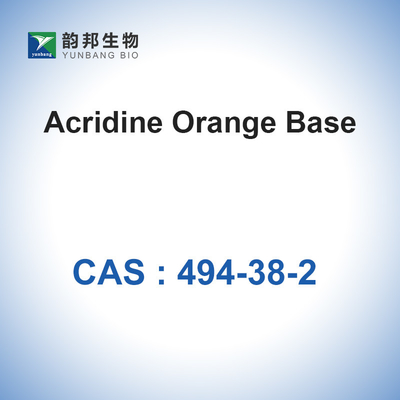Application
Acridine orange has also been used as a lysosomal dye. It is widely used to detect the presence of homeopathic potencies.
Purification Methods
The double salt with ZnCl2 (6g) is dissolved in water (200mL) and stirred with four successive portions (12g each) of Dowex-50 ion-exchange resin (K+ form) to remove the zinc. The solution is then concentrated in vacuum to 20mL, and 100mL of ethanol is added to precipitate KCl which is removed. Ether (160mL) is added to the solution from which, on chilling, the dye crystallises as its chloride. It is separated by centrifugation, washed with chilled ethanol and ether, and dried under vacuum, before being recrystallised from ethanol (100mL) by adding ether (50mL), and chilling. Yield 1g. [Pal & Schubert J Am Chem Soc 84 4384 1962]. It was recrystallised twice as the free base from ethanol or methanol/water by dropwise addition of NaOH (less than 0.1M). The precipitate was washed with water and dried under vacuum. It was dissolved in CHCl3 and chromatographed on alumina: the main sharp band was collected, concentrated and cooled to -20o. The precipitate was filtered off, dried in air, then dried for 2hours under vacuum at 70o. [Stone & Bradley J Am Chem Soc 83 3627 1961, Blauer & Linschitz J Phys Chem 66 453 1962, Albert J Chem Soc 244 1947, Beilstein 22 III/IV 5490, 22/11 V 326.]
FAQ
1:Can I get some samples before bulk order?
Most products provide free samples, but the shipping cost be paid by customers.
2: What's your MOQ?
We can have a discussion.
3: Which kind of payment terms do you accept?
PI will be sent first after confirmation of order,enclosed our bank information.Payment by T/T, Western Union,D/P, ETC.
4.How to place an order?
You can contact me through Trademanager, WhatsApp, Email and other contact methods, tell me the product and quantity you need, and then we will give you a quote.
5:How about your delivery time?
A: Generally, it will take 3 to 5 days after receiving your advance payment.
6:How do you treat quality complaint?
A:First of all, our quality control will reduce the quality problem to near zero. If there is a real quality problem caused by us, we will send you free goods for replacement or refund your loss.


 Your message must be between 20-3,000 characters!
Your message must be between 20-3,000 characters! Please check your E-mail!
Please check your E-mail!  Your message must be between 20-3,000 characters!
Your message must be between 20-3,000 characters! Please check your E-mail!
Please check your E-mail! 


